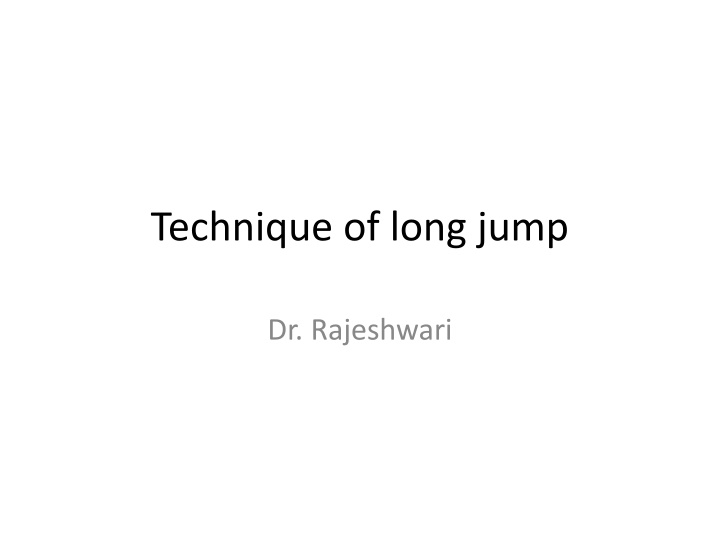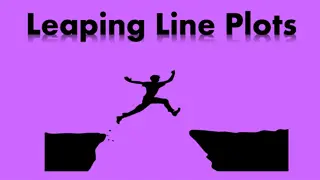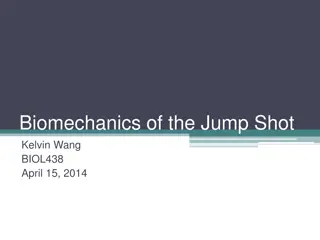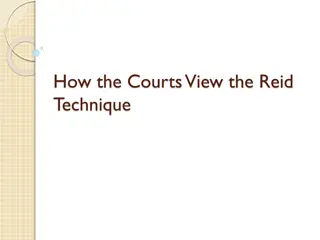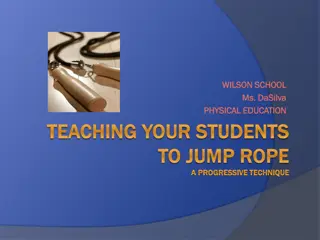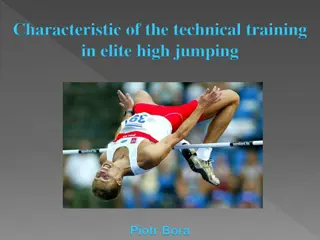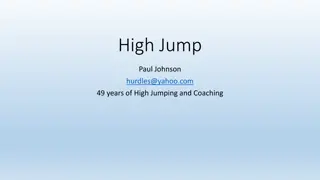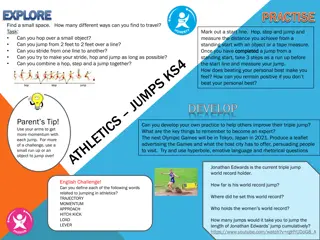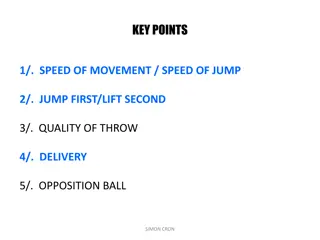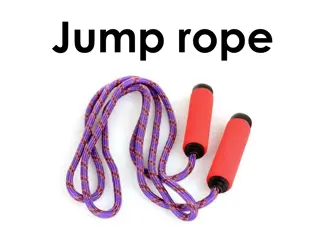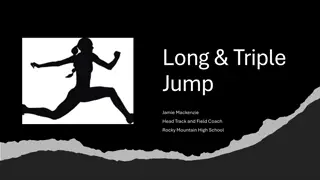Mastering the Long Jump Technique with Dr. Rajeshwari
The long jump, a combination of speed, technique, and precision, is more than just the jump itself. Dr. Rajeshwari explains the key elements such as setting up the approach, drive and transition phases, as well as the attack phase and final steps to excel in this track and field event. Learn from the experts like Jesse Owens and Carl Lewis who have perfected the art of the long jump by mastering the approach run and maximizing distance through effective technique.
Download Presentation

Please find below an Image/Link to download the presentation.
The content on the website is provided AS IS for your information and personal use only. It may not be sold, licensed, or shared on other websites without obtaining consent from the author.If you encounter any issues during the download, it is possible that the publisher has removed the file from their server.
You are allowed to download the files provided on this website for personal or commercial use, subject to the condition that they are used lawfully. All files are the property of their respective owners.
The content on the website is provided AS IS for your information and personal use only. It may not be sold, licensed, or shared on other websites without obtaining consent from the author.
E N D
Presentation Transcript
Technique of long jump Dr. Rajeshwari
Introduction The long jump can just as easily be named the run and jump or sprint and jump, because the actual jump is only part of the process. Yes, there are techniques for pushing off the board, for flying over the pit, and for landing. But these techniques, while important, can only maximize your distance, based on your takeoff speed. Once you re in the air, there s only a certain distance you can travel, based on the momentum you gained during the approach run, no matter how good your flight or landing techniques. That s why there s a history of great sprinters, from Jesse Owens through Carl Lewis, who ve excelled at the long jump. Successful jumpers understand that every truly long jump begins with a fast, efficient approach run.
Setting Up the Approach The objective of the approach run is for the athlete to achieve the ideal speed. Rhythm in the approach run is important to ensure the ideal speed is achieved at take-off and accuracy in hitting the take-off board. The athlete must develop a good running rhythm before accuracy is addressed. The length of the run will depend on the athlete's age and speed. There are different ways to determine the start of the approach run. One method is to stand with your back to the pit with the heel of your non-takeoff foot on the front edge of the board. Run forward the same number of strides you ll use for the approach and mark the provisional starting point. Make several approaches from that provisional spot, then adjust your starting point as needed to make sure your final step hits the takeoff board. Alternatively, set a designated starting point on the track and run forward. If your approach will be 20 strides long, mark the location of your 20th stride. Repeat the drill several times to determine your average 20-stride distance. If the average distance is 60 feet, place a marker 60 feet from the front of the takeoff board to begin the approach.
Approach Run Drive and Transition phases The Drive Phase is somewhat like a slower sprint start, but without the blocks. From a standing start, drive forward, keep your head down, with your arms pumping high. Each of the four approach run phases lasts four strides in a 16-stride approach. Begin to lift your head and gradually raise yourself into an upright running posture to start the Transition Phase. By the end of the transition phase, you should be in proper sprinting form, keeping your eyes up as you continue to accelerate.
Approach Run Attack Phase and Final Steps The Attack Phase is where all of your efforts go into sprinting. Your body is already upright, your eyes are focused on the horizon don t look for the board but you haven t yet begun preparing for takeoff. Run hard and light on your feet while maintaining proper, controlled sprinting technique and continue to build speed. Overall, the approach run through the first three phases should feature gradual, consistent, controlled acceleration. As you begin the final steps, the idea is to bring maximum speed into the board, but still be under control. Keep your head up. If you look down at the board you ll lose speed. Count on your training sessions to help you establish consistent strides so you hit the board and avoid fouling. Land flat-footed on the second-to-last step. Stretch a bit farther on this stride, to lower your hips and your center of gravity, and to place your center of gravity behind your front foot. Push off firmly with your flat foot, then make the final step a bit shorter than average.
Takeoff Generally, a right-handed long jumper takes off with the left foot. New jumpers may wish to try both to which style works best. When you hit the takeoff board, your body will actually be leaning slightly backward, with your foot in front, your hips slightly behind and your shoulders a bit behind your hips. As you plant the takeoff foot, throw your opposite arm back and lift your chin and hips as you push off the board. Your arms and free leg move upward. Your center of gravity, which was behind your lead foot on the penultimate step, moves ahead of your lead foot on takeoff. The takeoff angle should be between 18 and 25 degrees. Keep focusing directly ahead; don t look down at the pit.
Flight Stride Technique No matter which flight technique you employ, the idea is to maintain forward momentum without letting your upper body rotate forward and throw you off balance. The stride technique is just what it sounds like basically an extended stride. Your takeoff leg stays back, with your non-takeoff leg pointed forward and your arms high. As you come down your takeoff leg moves forward to join the other leg, while your arms rotate forward, down and back. The arms then move forward again as you land.
Flight Hang Technique As with all flight styles, the non-takeoff leg kicks forward after you push off from the board. Let the non-takeoff leg drop down to a vertical position, while the takeoff leg moves forward into a similar position. Your arms should be stretched above your head to prevent you from tipping forward. Just before the apex of your flight, bend your knees so your lower legs are approximately parallel to the ground. As you reach the apex, kick your legs forward so your entire legs are roughly parallel to the ground, while bringing your arms forward and down. Make sure your hands are above your legs when you land.
Flight Hitch Kick This style is like running in the air for the first half of your flight. The natural forward surge of the non- takeoff leg is like the first stride in the air. Bring it down and back as you lift your takeoff leg with a bent knee and kick it forward. At the apex your hands should be high over your head, your takeoff leg should point forward, approximately parallel with the ground, with your non-takeoff leg under you and your knee bent about as far as it will comfortably go. Leaving your takeoff leg in place, kick the non-takeoff leg forward as you descend, while swinging your arms forward, down, then behind your back. Pull your arms forward when you land.
Landing Distance is measured by the part of your body that contacts the pit closest to the takeoff line not the first part of your body that hits the sand. In other words, if your feet hit first, in front of you, then your hand touches the pit behind you, your distance will be marked at the point your hand hits. No matter which flight style you use, be sure to land feet first with your feet stretched as far in front of you as possible without any other part of your body touching the pit behind the original mark. When your heels touch the pit, press your feet down and pull your hips up. This action, combined with the momentum from your takeoff, must carry your body past the mark where your heels touched down.
